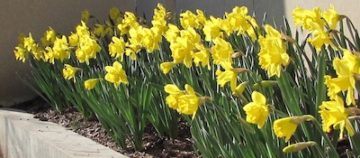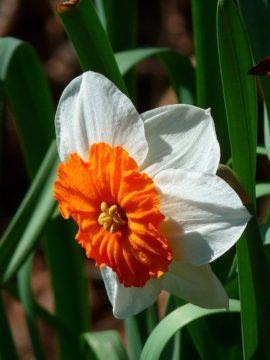by Mary Hrovat
 I don’t think I saw an actual daffodil until I was 19, although I had admired the many varieties I saw pictured in bulb catalogs and even—I hesitate to admit this—written haiku about daffodils (at 14, in an English class). When my first husband and I drove through Independence, Missouri, early in our marriage, I saw my first daffodils, a large clump tossing their heads in a sunshiny breeze. Wordsworth flashed upon my inner ear, and as I remember it, I recited “And then my heart with pleasure fills, and dances with the daffodils!” (If I did in fact say that, I’m sure I added the gratuitous exclamation point.) My husband, who was driving, gently asked me to return my attention to the map (I was navigating).
I don’t think I saw an actual daffodil until I was 19, although I had admired the many varieties I saw pictured in bulb catalogs and even—I hesitate to admit this—written haiku about daffodils (at 14, in an English class). When my first husband and I drove through Independence, Missouri, early in our marriage, I saw my first daffodils, a large clump tossing their heads in a sunshiny breeze. Wordsworth flashed upon my inner ear, and as I remember it, I recited “And then my heart with pleasure fills, and dances with the daffodils!” (If I did in fact say that, I’m sure I added the gratuitous exclamation point.) My husband, who was driving, gently asked me to return my attention to the map (I was navigating).
I delight in the names of cultivated daffodils (Silver Chimes, Falconet, Sorbet, Pink Parasol…), but for a very long time I didn’t understand the differences between daffodils, jonquils, and narcissi. Over the years I’ve become confused on a slightly higher level.
Narcissus is the name of a genus in the family Amaryllidaceae. This genus occurs naturally primarily in the Mediterranean region but is cultivated widely in other parts of the world, and some naturalized populations have escaped cultivation and thrived on their own. The word narcissus, with a lowercase n, can be used as a common name to describe members of this species.
The flowers of plants in this species vary quite a bit in appearance, but they have three basic forms: the daffodil, paperwhite, and trianthus forms. Among Narcissus species with the daffodil form, the things that we call daffodils are the wild Narcissus pseudonarcissus and its many cultivars. The bulbs of daffodils, like those of all narcissi, contain toxic alkaloids; in addition, their sap contains crystals of calcium oxalate. This explains why deer and rabbits leave my daffodils alone.
Jonquils (Narcissus jonquilla) are another species, which is distinguished by its reed-like leaves. (“Sedges have edges,” my memory interjects at this point, “and rushes are round.” Yes, very nice, thank you, but we are talking about narcissi now.)
###
The name jonquil is derived from the Latin iunco, which means reed or rush. (There’s also a a pale yellow color called jonquil and a bird called the jonquil parrot.) That’s the only straightforward etymology in this essay.
The word daffodil dates back only as far as the 16th century, but its roots go back much further. It’s derived from asphodel, a name with a particularly rich set of meanings. Asphodelus is a genus of perennial plants with spikes of flowers; there’s no close botanical relationship between the asphodels and the narcissi.
Mythologically, however, it’s a different story. Ancient Greek conceptions of the afterlife include a plant called asphodel, which may or may not have been the same as an ordinary asphodel plant or may even have been a type of narcissus, which explains the association with daffodils. Asphodel Meadows was the part of the afterlife where people who had led unremarkable lives would dwell. (Those of extraordinary virtue or heroic prowess would spend the afterlife in the Elysian Fields.)
Homer described Asphodel Meadows as gloomy and harsh—as something we might recognize as hellish. However, ancient Greek poets after Homer described it as a lush fragrant place, a view that later influenced in English poetry. The d at the beginning of daffodil might have been the result of erosion of the Dutch phrase “de affodil”, as daffodils often came from the Netherlands, where daffodil cultivars were bred.
The etymology of narcissus is similarly complex. The smell of Narcissus poeticus is so powerfully intoxicating (supposedly to the point of stupefaction) that the name narcissus may have come from the Greek word narkē, which means numbness (the word narcotic is also derived from this root). The derivation from the root word narkē has also been traced to the possible sedative effects of the alkaloids in the bulbs (but please do not ingest any part of a narcissus for any purpose whatsoever!). However, it’s not clear that any of these etymologies is correct. Some think that the word was introduced from another language than Greek.
###
Two well-known stories from Greek mythology are associated with narcissi. If you know anything about mythology (or psychology for that matter), you probably know the story of Narcissus, a strikingly handsome hunter who rejected all potential lovers and died of yearning for his own image reflected in a pool of water. In some versions of the myth, a narcissus flower was found after his death where his body should have been. Wild Narcissus pseudonarcissus do prefer damp areas, including springs and the banks of streams, but all we can say with any certainty is that the flower is associated with the hunter, not that either one takes its name from the other.
It was Narcissus poeticus that Persephone picked shortly before she was abducted into the underworld by Hades. In one version of the story, Hades created the sweet-smelling flower solely to lure her to the spot where his chariot was going to emerge from the earth. She fell asleep with a wreath of them on her head, in one telling, and was thus captured. The flowers were said to be white when she wove the wreath, but some turned yellow when she dropped them during her capture.
###
 Overall daffodils have a somewhat mixed set of meanings and associations. Because asphodel was associated with the afterlife in ancient Greek literature, and because of the story of Persephone and the underworld, daffodils have been associated with death. But because they appear in the spring, and in particular around the time of Easter, they represent renewal and new life. Cancer charities use them to signify hope.
Overall daffodils have a somewhat mixed set of meanings and associations. Because asphodel was associated with the afterlife in ancient Greek literature, and because of the story of Persephone and the underworld, daffodils have been associated with death. But because they appear in the spring, and in particular around the time of Easter, they represent renewal and new life. Cancer charities use them to signify hope.
Daffodils are also called Lent lilies (among other common names). They were traditionally thought to appear on Ash Wednesday and die on Easter. Because of their brief period of flowering, they have been used to suggest the brevity of life. The theme of Housman’s “The Lent Lily” is very similar to that of “Loveliest of Trees”: because “the Lenten lily … has not long to stay,” you must go to the woods to see it now. However, sometimes the association with Easter is more general; in Germany, Narcissus pseudonarcissus is called Osterglocke or Easter bell.
Daffodils are associated in the West with vanity, owing to the Greek myth of Narcissus, and in the East they signify wealth and good luck. But it’s not quite that simple; in the West they are said to bring either good luck or bad luck, depending on circumstances (you should never give someone a single daffodil, for example, as that’s bad luck, but a bunch of daffodils is OK). In the language of flowers, they may represent uncertainty, chivalry, respect, unrequited love, or new beginnings. If someone gives you a bunch of daffodils, you may assume they wish you well—if they’re familiar with that particular folk belief—but you’re on your own as far as interpreting what the giver is trying to tell you.
I was surprised to learn that the rose of Sharon mentioned in the Bible might have been a narcissus, although it’s also possible that it was a crocus, tulip, or lily. (The phrase itself, which sounds so much like a specific name, has also been translated more generically as “the flower of the field.”) I had assumed that it was related to the rose of Sharon growing in my yard (Hibiscus syriacus), but none of the plants that currently go by the common name rose of Sharon are likely to be related to the Biblical flower or to be native to the Levant. Hibiscus syriacus is native to eastern Asia; the species was named on the basis of specimens gathered from gardens in Syria, which explains the species name.
Keats numbered daffodils, quite rightly, among the things of beauty that are a joy forever. When William Wordsworth wrote “I Wandered Lonely as a Cloud,” which made such an impression on me when I was a teenager, he may have been inspired by a lovely description of daffodils that his sister Dorothy wrote while they were traveling together. She said the daffodils “tossed and reeled and danced and seemed as if they verily laughed with the wind that blew upon them.” Despite the brevity of their blooming, it’s hard for me to feel any connection between daffodils and death. It’s much easier to imagine them dancing and laughing in the wind, and to dream of dancing and laughing with them.
###
The first image is my own. The second is by LoggaWiggler from Pixabay.
You can see more of my work at MaryHrovat.com.
